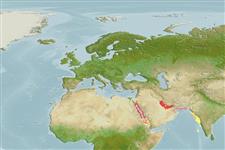Environment: milieu / climate zone / rango de profundidad / distribution range
Ecología
marino asociado a arrecife; rango de profundidad 10 - 40 m (Ref. 27115), usually 20 - 40 m (Ref. 27115). Tropical; 22°C - 27°C (Ref. 27115)
Western Indian Ocean: known only from the Red Sea.
Tamaño / Peso / Age
Madurez: Lm ? range ? - ? cm
Max length : 13.0 cm TL macho / no sexado; (Ref. 8883); common length : 10.0 cm TL macho / no sexado; (Ref. 9137)
Found among coral outcrops, in aggregations (Ref. 9710). Minimum depth reported from Ref. 9710.
Life cycle and mating behavior
Madurez | Reproducción | Puesta | Huevos | Fecundidad | Larva
Randall, J.E., 1986. Red Sea reef fishes. London, Immel Publishing. 192 p. (Ref. 8883)
IUCN Red List Status (Ref. 130435: Version 2025-1)
Threat to humans
Harmless
Human uses
Pesquerías: comercial; Acuario: Comercial
Herramientas
Special reports
Download XML
Fuentes de Internet
Estimates based on models
Preferred temperature (Referencia
123201): 22.2 - 29.4, mean 26.5 °C (based on 40 cells).
Phylogenetic diversity index (Referencia
82804): PD
50 = 0.5000 [Uniqueness, from 0.5 = low to 2.0 = high].
Bayesian length-weight: a=0.01122 (0.00514 - 0.02450), b=3.04 (2.87 - 3.21), in cm total length, based on all LWR estimates for this body shape (Ref.
93245).
Nivel trófico (Referencia
69278): 3.4 ±0.45 se; based on food items.
Resiliencia (Referencia
120179): Alto, población duplicada en un tiempo mínimo inferior a 15 meses (Preliminary K or Fecundity.).
Fishing Vulnerability (Ref.
59153): Low vulnerability (10 of 100).
🛈
Nutrients (Ref.
124155): Calcium = 96.9 [53.5, 189.1] mg/100g; Iron = 0.858 [0.471, 1.477] mg/100g; Protein = 18 [16, 20] %; Omega3 = 0.165 [0.100, 0.271] g/100g; Selenium = 25.2 [14.4, 49.0] μg/100g; VitaminA = 205 [70, 666] μg/100g; Zinc = 1.59 [1.06, 2.31] mg/100g (wet weight);
